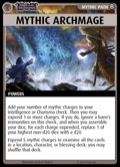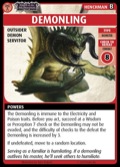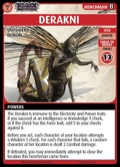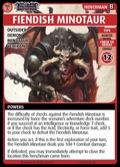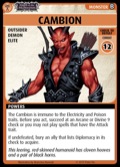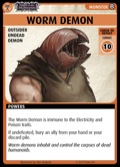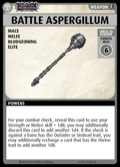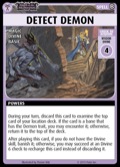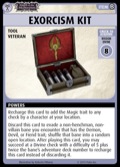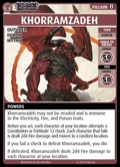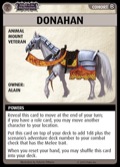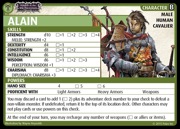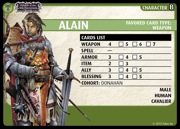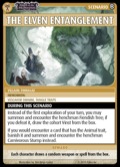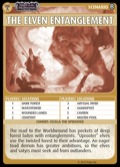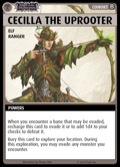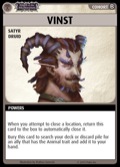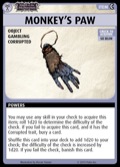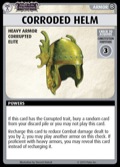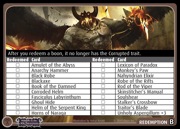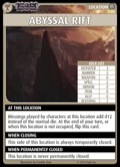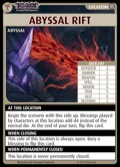Greetings and welcome to the Pathfinder Adventure Card Game: Wrath of the Righteous preview blog. I'm Paul Peterson, and I'll be your host as we delve into the depths of this demonic set. We've got a lot to cover here, and I'm going to reveal everything about this powerhouse set!
(Mike: Everything? No, you're actually not going to do that.)
Um, okay. Then... everything that you'll let me reveal.
(Mike: Okay. But rein it in. I'll be right over here. Watching.)
Okay! Hold on to your souls (at least for now), and let's dig in!
Mythic
From the beginning, I knew that bringing mythic heroes into the game was going to be exciting... and a huge challenge. I set some pretty lofty goals for this. First, the characters had to feel epic. They had to fight demon lords and travel to the Abyss and feel like it was well within their power to do so. Second, it had to be compatible with everything else. I wanted you to be able to bring Lem from Rise of the Runelords along and have him feel right at home.
So we created the mythic path cards.
At a certain point in the story, you get to pick one of these cards and add it to your character. You can pick any of them, so if you want Harsk to be a Mythic Guardian, you can make that choice (although you must live with the consequences afterwards).
These cards bring your characters up to a level more fitting of the word "mythic." At the start of each scenario, you add mythic charges to your card. These charges give you a bonus to EVERY roll of the dice for the skills associated with that path. You can also spend them to change 1 or more of your dice on a roll to a d20. That's right, a d20! And you can do it as often as you have charges to spend!
However, the players aren't the only ones who get to be mythic. What is the point of being a superhero if you don't have supervillains to face? Monsters get to be mythic as well, and defeating mythic monsters is one of the ways you can replenish your mythic charges.
Demons
As you might expect in an Adventure Path about an invasion from the Abyss, the set also has a few demons.
And when I say "a few," I really mean OH MY GOD, LOOK AT ALL OF THEM! They start off a little slowly in the base set, just to give you time to adjust and put your affairs in order, but by Adventure 6, they're an overwhelming horde of evil, pounding at your doors and demanding entry.
And where there are demons, there are things to help you fight them.
In this set, you'll find many tools that specifically target your evil foes, including weapons that bash them and spells that banish them.
Khorramzadeh
Speaking of mythic cards and demons, I'm just going to leave this right here for you to think about, right after I tell you that this is a card in the *Base Set*.
Cohorts
This adventure path has a strong focus on the NPCs you'll encounter. Some of them grow and change as they share adventures with the players. In addition, many of the characters we were looking at creating showed a deep connection to their companions. We brought all of that together to create a new type of card: the cohort.
Cohorts act much like allies, but most of them start in your hand instead of your deck. A few cohorts have owners and appear on an owner's cards list. For example, Donahan is owned by the cavalier Alain, so at the start of each scenario, Alain gets to add Donahan to his starting hand. (Similarly, summoner Balazar has his eidolon Padrig; in the Character Add-On Deck, hunter Adowyn has her wolf Leryn, and shaman Shardra has her stone spirit Kolo.)
Other cohorts, like Cecilla, are handed out as part of a particular scenario. After the players draw their starting hands, they get to decide who gets those cohorts. Alternatively, the scenario might create a condition under which you would get a cohort, as happens with Vinst. After the scenario, these cohorts are returned to the box until they're called for again. Oh, and if your cohorts get banished? They're gone forever. So don't let them get killed, because if you do, they're not coming back.
Corruption
One of my favorite things about this adventure path is the theme of corruption and redemption that appears time and time again. It was essential that we captured that theme in the card game as well.
Many boons in this set have the Corrupted trait. Corrupted boons have pretty severe drawbacks. However, you'll have opportunities to use the redemption card to redeem some of them. Once a boon is redeemed, the penalty is gone, and you're free to use the boon in all of its uncorrupted glory.
The Abyss
This set represents the first time that players really get a chance to spend some quality time on a plane other than their own.
Many of the locations in this set are in the Abyss, and the rules on a plane full of demons are not always the same as they are here. All of those lovely spells and weapons that give you extra dice when you're fighting an outsider don't work when your enemy is no longer considered one.
I hope you've enjoyed this peek at Wrath of the Righteous. In fact, I hope you're very excited (and a little afraid). I know that I am! I can't wait to tell you more about each of the adventure decks, especially Adventure Deck 3, where we'll be releasing...
(Mike: Okay, we're done here.)
WAIT... STOP... LET ME TELL THEM!
(Mike: Please ignore the sound of grinding and manacles.)
Paul Peterson
Adventure Card Game Designer





